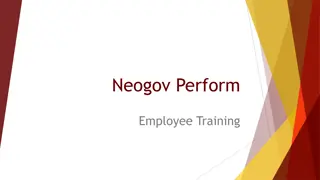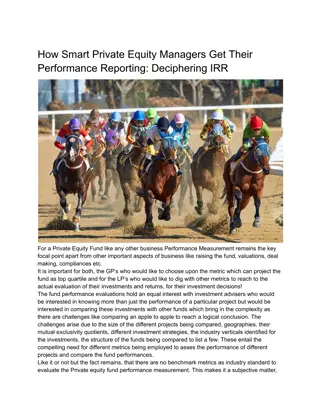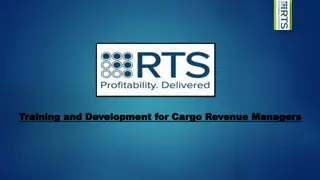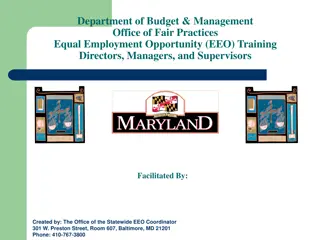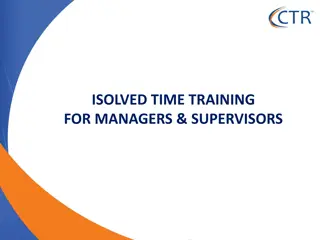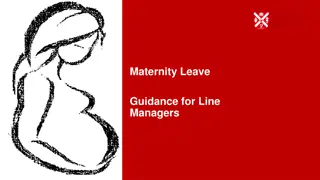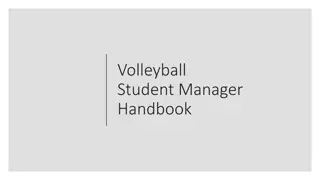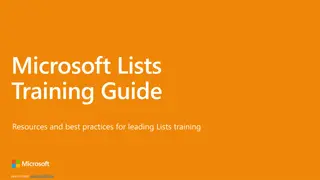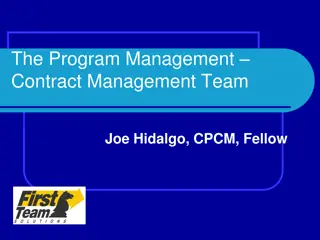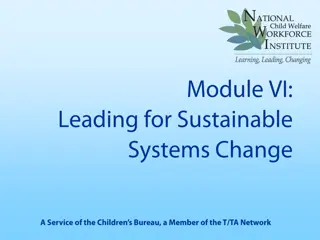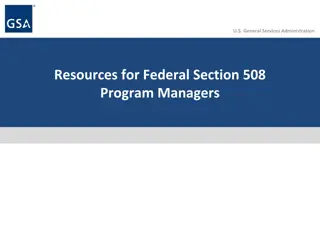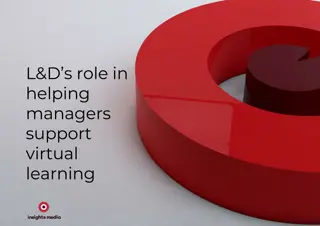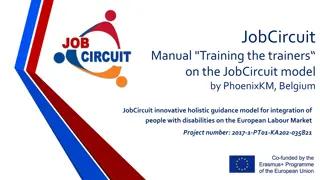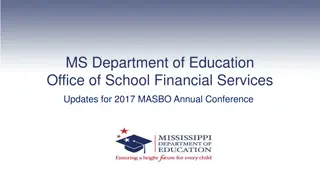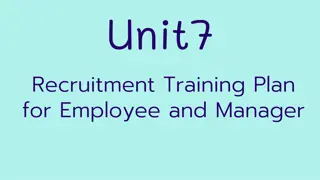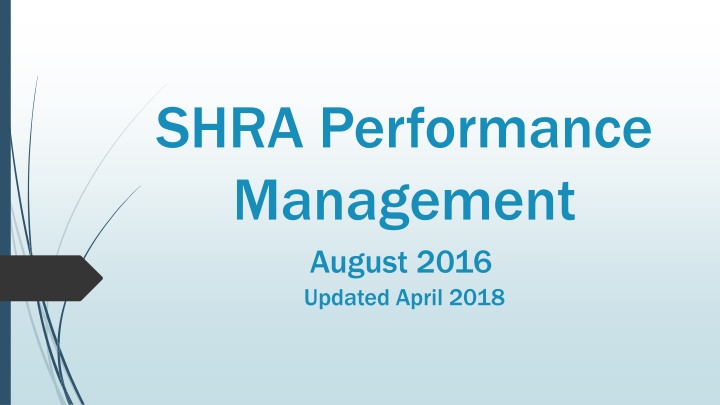
Performance Management Program: Key Changes, Expectations, Roles & Responsibilities
Explore the key changes in the Performance Management Program from August 2016 updated in April 2018, including shifts in wording, new performance plan structures, recalibration processes, and clear communication of expectations. Learn about the philosophy, roles, and responsibilities outlined to help employees succeed effectively.
Uploaded on | 2 Views
Download Presentation

Please find below an Image/Link to download the presentation.
The content on the website is provided AS IS for your information and personal use only. It may not be sold, licensed, or shared on other websites without obtaining consent from the author. If you encounter any issues during the download, it is possible that the publisher has removed the file from their server.
You are allowed to download the files provided on this website for personal or commercial use, subject to the condition that they are used lawfully. All files are the property of their respective owners.
The content on the website is provided AS IS for your information and personal use only. It may not be sold, licensed, or shared on other websites without obtaining consent from the author.
E N D
Presentation Transcript
SHRA Performance Management August 2016 Updated April 2018
Key Changes Changes in Wording Changes in Wording Work Plan = Performance Plan Organizational Values = Institutional Goals Performance Goals = Individual Goals Performance Cycle Performance Cycle: April 1 Calibration Sessions Calibration Sessions Weighting Weighting- - Institutional Goals & Individual Goals each equal 50% 3 3- -Point Point S Scale for All Ratings cale for All Ratings All SHRA Employees Receive All SHRA Employees Receive S Same Performance Document : April 1- - March March 31 31 ame Performance Document
Performance Management & Expectations
Performance Management Program Philosophy Program Philosophy The performance management program is a communications system designed to help the employee succeed. Goals Goals of Communication System of Communication System Clarity on job duties and performance expectations Clarity on dynamics of working relationship
Roles & Responsibilities Employee Employee Actively participate & own the work Ask questions & keep supervisor informed Supervisor Supervisor Clarity in expectations & Honesty in appraisal Invest time upfront & use available resources Second Second- -Level Supervisor Level Supervisor Review & sign all performance plans & performance reviews Ensure expectations/ratings applied consistently
Recalibration Goal Goal of Need (Meets) vs. Want (Exceeds) of Recalibration Recalibration Calibration Sessions Calibration Sessions Communication process in which peer supervisors within a defined unit establish goals and metrics to ensure consistent application of performance expectations and ratings across similar positions Goal Calibration at beginning of performance cycle to review & clarify expectations for institutional goals & set individual goals Rating Calibration at end of cycle to apply consistent, equitable & fair ratings for work performed in similar positions
Setting Expectations Entry in ConnectCarolina for all personnel actions Meeting Meeting Not Meeting Not Meeting Exceeding Exceeding 1 1st st Friday of Next Biweekly Friday of Next Biweekly P R O A C T I V E R E A C T I V E Timely? Quantity? Accuracy? Autonomy? Manner? Manner? Timely? Quantity? Accuracy? Autonomy?
Performance Plan Due October 1, 2016 for 2016 Due October 1, 2016 for 2016- -17 Cycle April 1 for all following cycles 3 Parts 3 Parts of Performance Plan of Performance Plan 5 Institutional Goals (6 for Supervisors) 3-5 Individual Goals Talent Development Plan (Developmental Goals) Sections Sections 1 1- -5 of the University SHRA Performance Appraisal 5 of the University SHRA Performance Appraisal Form Form 17 Cycle
Institutional Goals Standardized across campus Standardized across campus 5 key aspects of employee work (plus one additional for supervision) Address all work product (both performance and conduct) of the employee for the performance cycle Expectations can be supplemented by other resources Expectations can be supplemented by other resources Discuss Institutional Goals in conjunction with Position Description Provide additional specificity as needed for certain job duties. SOPs, protocols, procedurals, policies
Institutional Goals Expertise Expertise Precision Resourcing Innovation Development
Institutional Goals Accountability Accountability Productivity Autonomy Prioritizing Coordination
Institutional Goals Customer Customer- -Oriented Oriented Clarity Awareness Attentiveness Diplomacy
Institutional Goals Team Team- -Oriented Oriented Collegiality Collaboration Contribution Attendance
Institutional Goals Compliance & Integrity Compliance & Integrity Policy Safety Ethics Respect
Institutional Goals Supervision Supervision (if applicable) (if applicable) Oversight Goal-Setting Talent Management Leading
Individual Goals 3 3- -5 individual goals defined each year 5 individual goals defined each year Organizational goals Work unit goals Individual/Position-based goals Not intended to cover all aspects of employee work product Not intended to cover all aspects of employee work product Focus on key results/outcomes, not steps in the process Clarify meeting, exceeding, or not meeting expectations
How do I write an Individual Goal?
Individual Goals by Function Critical Critical- -Function / Deal Breaker Goals Function / Deal Breaker Goals Key deliverables that are essential to the position Often compliance-driven Project Project- -Oriented / Big Ticket Goals Oriented / Big Ticket Goals Time-specific work in current cycle (eg, grant phases) Unique projects for current cycle (eg, hiring, clean-up ) Forward Forward- -Focused / Stretch Goals Focused / Stretch Goals Activity more aligned with University strategic goals Designed to move the organization forward in some way
Individual Goals by Scope Division Division- -Wide Goals Wide Goals Often tied to University strategic goals or initiatives May have some variation based on employee roles Work Work- -Unit / Job Unit / Job- -Class Goals Class Goals Goals to improve/sustain work product or team dynamics Goals relevant to particular type of work or team needs Employee Employee- -Specific Goals Specific Goals Specific to the regular duties of the employee Specific to the development of the employee ( stretch )
S Specific List the details of what you want to accomplish. M Measurable How will you evaluate your goal? A Achievable Is your goal challenging but still realistic? R T Relevant Does your goal tie into your responsibilities? Time-bound Does your goal include a deadline? E Expectations Is your goal ethical, exciting, and enjoyable? R Resources What resources will you commit to achieving your goal?
Sample Goal: Outreach Initiative How would we write a goal for an HR Consultant to develop an How would we write a goal for an HR Consultant to develop an Outreach Initiative for campus? Outreach Initiative for campus? S Specific (What needs to be accomplished? What outcomes?) M Measurable (What data can be used to define success?) A Achievable (Is this challenging, but realistic?) R Relevant (Does this align with broader goals/needs?) T Time-bound (What are the deadlines/Milestones?) Expectations (Is it ethical, exciting, and enjoyable?) Resources (What assistance will be provided for this?)
Talent Development Plan
Talent Development Plan Development Goals specifically designed for person, not position: Development Goals specifically designed for person, not position: Employee s personal career goals Growth opportunities within unit or University Developing/sustaining competencies needed in current position or employee s career path
Talent Development Plan Examples: Examples: Required/career-path credentials/certifications Work-related skill development/refreshers Academic coursework or continuing education Recommended for all employees (Expected for Not Meeting): Recommended for all employees (Expected for Not Meeting): At least one development activity
Corrective Action Plan Mandatory Mandatory if if: If the overall rating or the ratings on one or more institutional goals or individual goals does Not Meet Expectations on any appraisal; or Employee must acquire new knowledge or skill to maintain performance at or above Meets Expectations" level or achieve competency level required for position Define in the annual appraisal and carry over to the Talent Define in the annual appraisal and carry over to the Talent Development Plan for the next cycle. Development Plan for the next cycle.
Weighted Goals Weighting of Annual Appraisals* Weighting of Annual Appraisals* Individual Goals 50% 50% Institutional Goals *No goal can be weighted lower than 5%
Performance Planning Conference
Performance Planning Conference Preparation Preparation Supervisor writes/edits performance plan 2nd-level supervisor reviews/signs Suggested: Provide performance plan prior to conference Performance Performance Planning Conference Planning Conference Supervisor meets with employee to discuss (required) Discuss each Individual/Institutional Goal (revise if needed)
Performance Planning Conference Performance Performance Planning Keep it a dialogue: Listen as much as you speak Employee/supervisor sign performance plan (be sure employee gets a copy) Planning Conference (continued) Conference (continued) Mid Mid- -year Follow same process, OR Send employee an addendum (email/memo) to include with performance plan year changes or further clarifications? changes or further clarifications?
Performance Appraisal
Performance Appraisal Annual performance appraisals: Cycle ends March 31 Annual performance appraisals: Cycle ends March 31 Appraisal Due: April 30 Supervisor: Writes/edits appraisal 2nd-Level Supervisor: Quality Control Covers totality of performance cycle Preparation: Preparation: May request self-evaluation/report from employee Suggested: Appraisal provided in advance Employee must have worked Employee must have worked for the State months months to receive annual to receive annual appraisal appraisal for the State for for at least at least 6 6
Performance Appraisal Rate performance based on expectations Rate performance based on expectations Give strong specific examples that reflect overall work Avoid nit-picking minor infractions Use more observation and less inference Take steps to avoid rater bias Emphasize work performed above Overall performance comments Overall performance comments Wrap-up statement of overall contribution May address achievements or concerns that fall outside Goals Must hold a one Must hold a one- -on on- -one review session with each employee one review session with each employee above and below below Meets level
Performance Appraisal If a Disciplinary If a Disciplinary A Action Was Issued Not Meeting Expectations for Goal(s) relevant to active disciplinary action Despite overall rating, employee cannot receive overall rating of Exceeds Expectations with any ratings of Not Meeting Expectations ction Was Issued D During uring P Performance erformance C Cycle: ycle:
Performance Appraisal Off Off- -Cycle Reviews Cycle Reviews Interim Interim R Reviews Probationary Reviews Probationary Reviews- Completed quarterly Other Reviews Other Reviews: Employee-Requested Reviews Employee can request once a cycle Must be at least 60 days after last review Transfer Reviews- Completed when supervisor or employee transfers eviews- Completed near the middle of cycle (around October)
Performance Appraisal Employee Response Employee Response The form includes a box to indicate that there are comments attached Can be attached to the appraisal document at anytime There is no deadline, but normally completed within two weeks of review Appeals deadline is 15 calendar days after receiving an Appeals deadline is 15 calendar days after receiving an overall rating of Not Meeting Expectations rating of Not Meeting Expectations Employee may request a Facilitated Conversation for Not Employee may request a Facilitated Conversation for Not Meeting Expectations for any goal Meeting Expectations for any goal overall
Appraisal Scoring Institutional Goal and Individual Goal Scores Institutional Goal and Individual Goal Scores 3 = Exceeding Expectations 2 = Meeting Expectations 1 = Not Meeting Expectations Final Overall Rating Final Overall Rating 2.70 to 3.00 = Exceeding Expectations * * 1.70 to 2.69 = Meeting Expectations 1.00 to 1.69 = Not Meeting Expectations *If received disciplinary action and/or any rating of Not Meeting, then Final Overall Rating cannot be higher than Meeting.
Appraisal Scoring Overall Score: Overall Score: 1.30 + 1.20 1.30 + 1.20 = 2.50 = 2.50 Meeting Expectations Meeting Expectations



